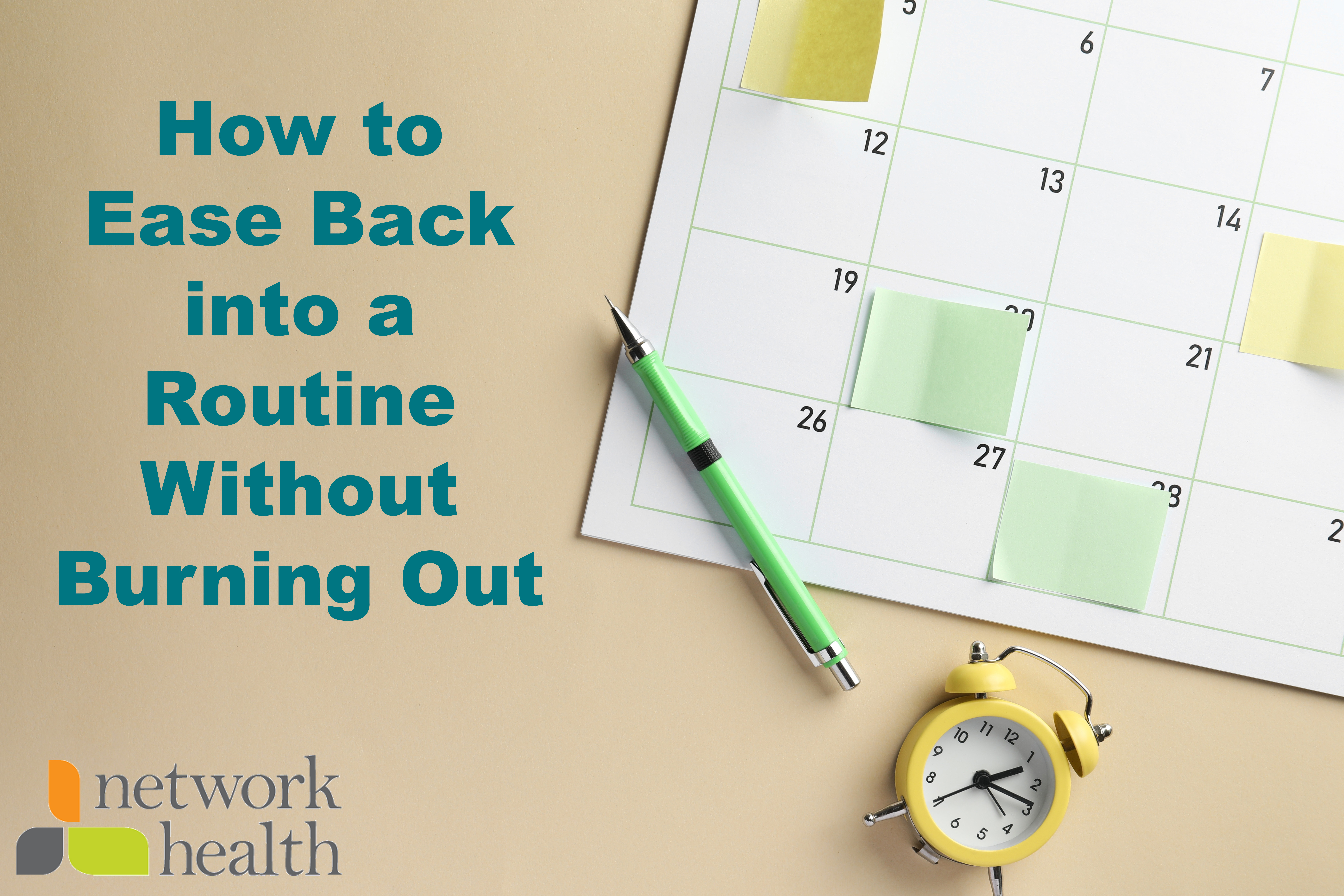Good Posture is Straight Up Good for Your Whole Body

Understanding the Importance of Posture
By Samantha Clark, supervisor of wellness at Network Health
5/17/2022
If you’re somebody who is concerned with their health and wellness, you are probably taking steps like eating the healthy nutritious meals your body needs, monitoring your activity levels and ensuring you’re getting adequate sleep every night.
Is it possible, however, that we’re missing a key element of whole-body health and wellness? As you may have guessed by the title of this article, it’s posture.
We’re all familiar with the movie scenes where a character has to attend an etiquette course or finishing school and is made to walk with a book on their head.
Unfortunately, these portrayals may have convinced us that posture was strictly a social grace for high society types. In reality, posture impacts more than just your physical appearance. Having good posture positively influences your physical, emotional and mental well-being, enhances your quality of life and can even be a predictor of longevity.
So, while there’s little need for most of us to learn how to walk with a book on our head, learning about posture’s impact on our body and mind and focusing on steps we can take to improve our posture goes a long way to helping us feel healthier and stronger.
What is posture?
Posture is defined as balance, alignment and movement of the body while in any given position, whether that’s lying, seated or standing.
Ideally, proper posture should involve total body alignment, meaning your ears should be aligned over your shoulders, shoulders aligned over your hips and (if standing) hips aligned over your ankles.
This position allows your weight to be evenly distributed down your spine and on both sides of the body. When you aren’t in alignment, the imbalance creates extra pressure on areas of the spine and certain joints, which can trigger a cascade of negative health effects.
What does good posture do for me?
From a physical wellness perspective, proper posture limits pain and helps preserve your range of motion long-term. Similarly, you maintain flexibility, balance and coordination.
One area you may not know can be affected and improved by good posture is breathing. Having good posture enables you to breathe deeper, as your lungs and organs aren’t being compressed.
Less internal pressure also reduces your risk for poor circulation, improper digestion and heart disease.
On the flip side, a more commonly known benefit of good posture is reduced back pain. Even weight distribution keeps pressure from concentrating on joints and vertebrae in your back. This balanced pressure can reduce your risk of developing arthritis.
Good posture is more than just physical wellness, however. From a mental perspective, physical alignment through good posture helps to ensure that your nervous system (brain, spinal cord, etc.) is all functioning well and communicating with the other parts of your body.
Good posture influences your mental capacity, helping your short-term memory and information recall, as well as increasing your alertness and concentration. The combined benefits of these individual parts are more creativity, better problem-solving and higher-level thinking. It can even help you feel and be more productive at work.
We talk frequently about getting enough sleep, but if you do manage to miss a few Zzz’s the night before, focusing on your posture can help counteract some of the negative effects of sleep deprivation.
Finally, posture helps your emotional self by alleviating stressors, reducing anxiety levels and promoting a higher sense of self-esteem.
Good posture is whole-body care.
How can I improve my posture?
Health experts often use the phrase “A.C.E. your posture,” to help their patients remember the steps to good posture. A.C.E. stands for Awareness, Control and Environment.
Awareness
Your physical posture is an outward reflection of the way you feel and your internal state. Becoming aware of this internal state through mindfulness and attention helps reconnect your mind and body.
Here are some ways to be more aware of your emotions and internal state.
- Ask someone to take your picture from the front and side views to self-evaluate your posture. Check the alignment of your head, shoulders, hips and ankles from one side to the other. Is everything level? Do you feel like the photographs exemplify the ideas of balance and alignment?
- Notice how you are breathing. What body parts move while you breathe – your diaphragm or your chest and shoulders? Often, individuals with ‘forward head posture’ use their chest and shoulders to breathe called ‘forward head breathing.’ Ideally, you want to be breathing through your belly while your chest and shoulders remain still. This habit can be corrected by re-training yourself to belly breathe.
Control
After you have some awareness of your posture and how it is serving to communicate your internal state, the next step is to control those things. Focus on slow, rhythmic breathing while moving to this state and work to do the following.
- Stand tall and relaxed – Imagine a string attached to the very top and center of your head that is pulling you up towards the ceiling, while your chin is parallel to the ground, ears stacked over your shoulders and shoulders stacked over your hips.
- Open your torso – Roll your shoulders up and back upon inhale and keep them back as you lower them down upon exhale.
- Center your pelvis – Arch your lower back while you inhale, then tuck your pelvis (belly button to spine) as you exhale. Maintain a long spine and tall head as you roll your pelvis back to center (neutral).
- Ground your feet – Rise up onto your tiptoes, then down to flat feet. Next, rock back onto your heels and spread your toes apart, then down to flat feet. Roll your feet out and then roll them back in. Lastly, press all surfaces of each foot into the ground.
- Belly breathe – Practice taking slow breaths in and out through your diaphragm, which relaxes the shoulders, lengthens the spine and improves posture. You will feel your belly push out when you inhale and relax when you exhale.
- Make time for daily posture breaks – Try incorporating the above exercises for five minutes, a couple of times every day. The optimal time, you find, might be after a meeting, during your daily stretch break, at lunch, after work before heading home or while getting up for a bathroom break. Like any element of fitness, the best method is the one you will remember to incorporate.
Environment
Consider ways to adjust your environment in a way that encourages better posture throughout your daily activities.
- Sitting – Select a chair that promotes erect posture from the waist up or consider investing in a support or wedge that tilts the hips forward from beneath you. Schedule or set an alarm for short movement or stretch breaks.
- Standing/moving – Your feet are the foundation of your posture. Proper footwear that is equally comfortable and supportive (with arch support) is ideal to maintain muscle balance and alignment on both sides of the body. The wear patterns on the soles of your shoes indicate postural and balance habits.
- Sleeping – Investing in a mattress and pillows that are as equally comfortable and supportive as your footwear are other components to keeping your body well aligned. Side sleepers benefit from two pillows, one behind the head that fills the space between the ear and shoulder while keeping the neck in alignment and another pillow between the knees for pelvic and spinal support. Back sleepers benefit from a contoured pillow that keeps the neck in alignment and airway open for nasal breathing.
Overall, correct posture allows the opportunity for all body systems to function to their fullest capacity so that you can reap the greatest short-term benefits and long-term benefits possible.
For more information on how your Wisconsin health plan can help you feel your best through wellness coaching, preventive care and more, contact us today.



